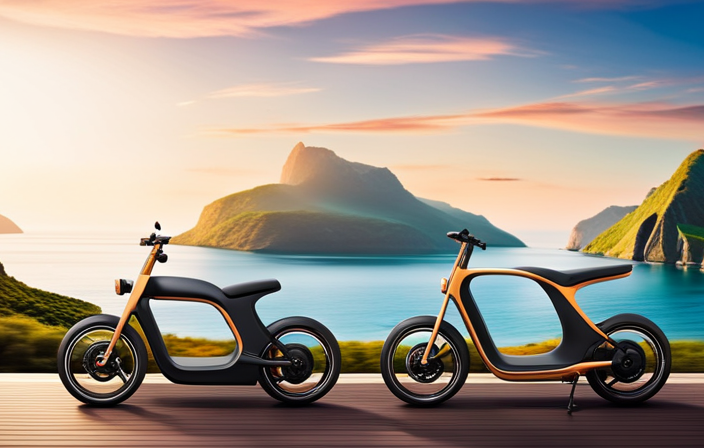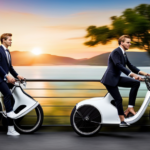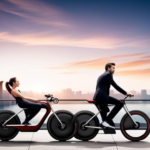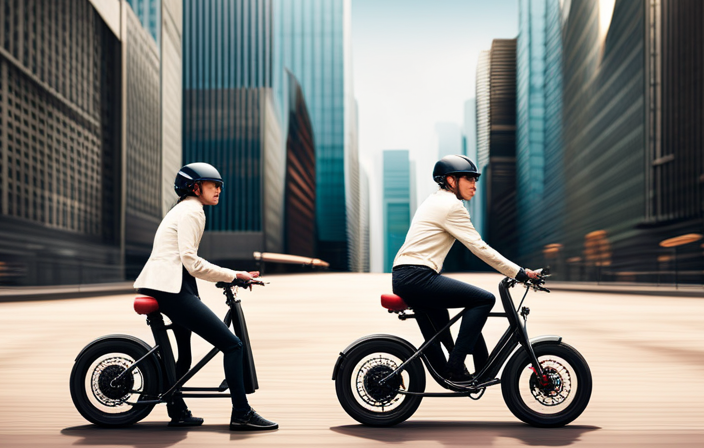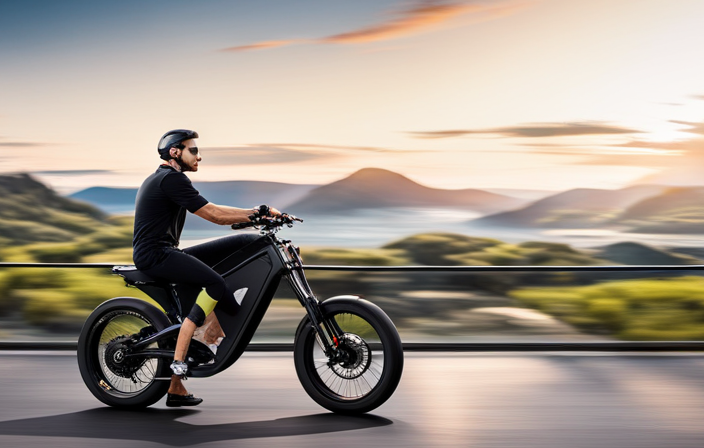Prepare yourself to go the extra mile! Electric bikes have endless possibilities when it comes to battery capacity, motor power, and pedal assist levels. They are changing the way we travel and discover new places. With advancements in technology, e-bikes are becoming more efficient and accessible for riders of all experience levels. Whether you’re commuting to work or exploring rugged trails, these bikes offer a fun and eco-friendly way to get around. If you’re wondering how old to ride an ebike, age requirements can vary depending on local laws and regulations, so it’s important to check before hitting the road.
But how many miles can they really go? In this article, we’ll dive deep into the factors that determine an electric bike’s range. From terrain and rider weight to weather conditions and battery management, we’ll explore every detail to give you a comprehensive understanding of just how far an electric bike can take you.
Key Takeaways
- Factors such as uphill climbs, rough terrains, heavy loads, and extra passengers can affect the range of an electric bike.
- Efficient riding techniques such as avoiding unnecessary accelerations, pedaling along with the electric motor, and maintaining a steady speed can increase the bike’s range.
- Weather conditions, including sunny days, wind resistance, and tailwinds, can impact the battery life and mileage of an electric bike.
- Battery management practices such as maintaining charge level between 20-80%, avoiding extreme temperatures, and regular inspection and replacement of worn-out parts can help prolong the battery’s longevity.
Battery Capacity
You can check the battery capacity of an electric bike to determine how many miles it can go. The battery life of an electric bike refers to how long the battery can power the bike before needing to be recharged. It is measured in watt-hours (Wh) and can range from around 200Wh to over 1,000Wh.
A higher battery capacity generally means a longer range for the electric bike. However, it’s important to note that other factors such as terrain, rider weight, and assist level can also affect the overall range.
Additionally, charging time is another crucial aspect to consider. Some electric bikes may take several hours to fully charge, while others can be charged in just a few hours.
Considering these factors will help you determine how far an electric bike can go on a single charge.
Moving on to the subsequent section about motor power…
Motor Power
With a higher motor power, you’ll be able to cover greater distances on your e-bike. The motor power determines how much force the motor can produce, which directly affects the speed and range of your electric bike.
Motor efficiency plays a crucial role in determining how far your e-bike can go on a single charge. A more efficient motor will convert a higher percentage of the battery’s energy into actual propulsion, resulting in a longer range.
Additionally, motor power is also important in range calculations. A higher motor power allows the e-bike to overcome inclines and headwinds more easily, thus increasing the overall range.
Understanding the motor power and efficiency will help you make an informed decision when choosing an electric bike.
Now, let’s move on to the next section about pedal assist levels.
Pedal Assist Levels
The pedal assist levels on an e-bike determine how much assistance the motor provides while pedaling. With different levels of pedal assist, you have the ability to customize your riding experience and conserve battery power. Here is a table that shows the advantages and disadvantages of different pedal assist levels:
| Pedal Assist Level | Advantages | Disadvantages |
|---|---|---|
| Level 1 | Longer battery life, more exercise | Limited assistance, slower speeds |
| Level 2 | Balanced assistance and exercise | Moderate battery consumption |
| Level 3 | Maximum assistance, less effort | Shorter battery life, less exercise |
By adjusting the pedal assist level, you can decide how much effort you want to put into pedaling and how much assistance you need from the motor. This allows you to extend your range and go farther on a single charge. Now, let’s explore how terrain and elevation affect the performance of an electric bike.
Terrain and Elevation
Terrain and elevation can greatly impact the performance and efficiency of an e-bike. When exploring off-road capabilities, it is important to consider how the bike will handle different types of terrain. Steep inclines, for example, can put a strain on the motor and battery, reducing the overall range of the bike.
To help you understand the impact of terrain and elevation, here are four key points to keep in mind:
-
Uphill Performance: Climbing steep hills will drain the battery faster and require more effort from the motor. This can significantly reduce the distance you can travel on a single charge.
-
Downhill Regeneration: On the flip side, when going downhill, some e-bikes have regenerative braking systems that can help recharge the battery, increasing the overall range.
-
Rough Terrain: Riding on rough, uneven surfaces can also impact the battery life and overall efficiency of the bike. The motor may have to work harder to maintain stability and traction.
-
Range Variability: It’s important to note that the range of an e-bike can vary depending on the specific model, battery capacity, and other factors.
Considering the impact of terrain and elevation is crucial when determining how far an e-bike can go.
Now, let’s delve into another important factor: rider weight.
Rider Weight
If you’re wondering how rider weight affects the range of your e-bike, we’ve got the answers for you. Understanding the impact of your weight on the battery life can help you optimize your range and make the most out of your electric bike.
By exploring strategies such as adjusting your riding style, managing your load, and considering bike features, you can ensure a longer and more efficient ride.
Learn how rider weight affects e-bike range
When it comes to e-bike range, rider weight has a direct impact. Optimizing battery and increasing efficiency becomes crucial to maximize the distance you can travel on your electric bike.
Here are four important factors to consider:
-
Weight distribution: Distributing your weight evenly across the bike helps maintain balance and reduces strain on the battery.
-
Aerodynamics: A streamlined riding position minimizes wind resistance, allowing the bike to glide smoothly and preserve energy.
-
Tire pressure: Keeping your tires properly inflated reduces rolling resistance, making it easier for the motor to propel the bike forward.
-
Riding style: Riding at a consistent speed and avoiding sudden accelerations and decelerations helps conserve battery power.
By understanding how rider weight affects e-bike range and implementing these strategies, you can optimize your range based on your weight.
Now, let’s explore strategies to further enhance your e-bike’s efficiency.
Explore strategies to optimize range based on your weight
To optimize your range based on your weight, start by considering your riding habits and making adjustments accordingly.
When it comes to weight distribution, aim to evenly distribute your weight on the bike to ensure stability and prevent unnecessary strain on the battery.
Analyzing aerodynamics is also crucial in maximizing your e-bike’s range. Reduce wind resistance by positioning your body in an upright position and tucking in your elbows and knees. Additionally, consider wearing aerodynamic clothing and accessories.
Another helpful tip is to avoid excessive braking and sudden acceleration, as these actions can drain the battery quickly.
By implementing these strategies, you can extend the mileage of your electric bike.
Now, let’s delve into the next section about riding style and speed to further enhance your e-bike’s range.
Riding Style and Speed
When it comes to e-bike range, your riding style plays a crucial role. Understanding how your riding style affects the range can help you make the most out of your electric bike.
By adopting efficient riding techniques, such as maintaining a steady speed and avoiding sudden accelerations, you can maximize your e-bike’s range and enjoy longer rides without worrying about running out of battery.
Understand the relationship between riding style and e-bike range
The riding style of the cyclist directly affects the range of an e-bike. How you ride can greatly impact the distance your electric bike can travel on a single charge. Here are some key factors to consider:
-
Rider fitness: The amount of effort you put into pedaling affects the energy consumption of the e-bike. If you rely heavily on the motor and rarely pedal, the battery will drain faster, resulting in a shorter range.
-
Energy consumption: Riding at higher speeds or constantly accelerating and braking can significantly increase energy consumption. Smooth and steady riding conserves battery power and extends the range.
-
Terrain: Uphill climbs and rough terrains increase the demand on the motor and drain the battery faster. Riding on flat surfaces or downhill stretches allows for more efficient energy usage.
-
Weight: Carrying heavy loads or extra passengers adds strain to the motor and reduces range. Lightening the load can help maximize the e-bike’s range.
-
Tires and tire pressure: Properly inflated tires with lower rolling resistance can improve efficiency and extend the range.
By understanding the relationship between riding style and e-bike range, you can discover tips for maximizing range through efficient riding techniques.
Discover tips for maximizing range through efficient riding techniques
Improve your e-bike’s range by implementing efficient riding techniques. By optimizing your riding style, you can maximize the distance you can go on a single charge.
One key technique is to maintain a steady and consistent speed, avoiding unnecessary accelerations and decelerations. By doing so, you can conserve energy and extend your e-bike’s range.
Another tip is to pedal along with the electric motor, rather than relying solely on the motor’s power. This not only increases your range but also provides a good workout.
Additionally, try to ride on flat terrain whenever possible, as uphill climbs can drain the battery quickly.
By utilizing these efficient riding techniques, you can significantly increase the range of your e-bike.
Transitioning to the next section about weather conditions, it’s important to consider how different weather factors can impact your e-bike’s range.
Weather Conditions
On a sunny day, you can go even further on your electric bike. When it comes to maximizing the range of your electric bike, the weather conditions play a crucial role. Optimal clothing can greatly impact your riding experience and the overall range of your bike. Wearing lightweight and breathable clothing can help reduce wind resistance and keep you comfortable during your ride.
Speaking of wind, it can significantly affect your bike’s range. Riding against strong headwinds can drain your battery faster, while tailwinds can provide a boost and help you go the extra mile. It’s important to be aware of the weather forecast and plan your rides accordingly.
Now, let’s dive into the next section about battery management and maintenance, where you’ll learn how to prolong the life of your electric bike’s battery.
Battery Management and Maintenance
Discover the best practices for managing and maintaining your e-bike battery to ensure optimal performance.
Learn how to extend the lifespan of your battery by following these key points.
By implementing proper battery management techniques, you can maximize the distance you can travel on a single charge and improve the overall efficiency of your electric bike.
Discover best practices for battery management and maintenance
Battery management and maintenance for electric bikes are essential for maximizing the distance the bike can travel. Proper battery charging and storage techniques can significantly extend the lifespan of an e-bike battery, ensuring optimal performance and range. Here are some best practices to help you get the most out of your electric bike battery:
| Column 1 | Column 2 | Column 3 |
|---|---|---|
| Charge Level | Charging Method | Storage Temperature |
| 20-80% | Slow and steady | Cool and dry |
| Avoid extremes | Avoid fast charging | Avoid extreme heat |
Maintaining the battery charge level between 20-80% and avoiding extremes in both charging and storage can help prolong the battery’s life. Slow and steady charging is recommended over fast charging, as it puts less stress on the battery cells. Additionally, storing the battery in a cool and dry environment, away from extreme heat, can prevent damage and degradation.
By following these battery management and maintenance practices, you can enhance the longevity of your e-bike battery and ensure that it continues to provide you with optimal performance. In the next section, you will learn how to extend the lifespan of your e-bike battery by implementing additional strategies.
Learn how to extend the lifespan of your e-bike battery
To extend the lifespan of your e-bike battery, you should implement additional strategies that can help optimize its performance. Here are some tips for battery longevity:
-
Proper charging: Always use the charger provided by the manufacturer and avoid overcharging the battery. Charge it in a cool environment to prevent overheating.
-
Avoid extreme temperatures: High temperatures can degrade the battery faster, so avoid leaving your e-bike in direct sunlight or in freezing conditions for extended periods.
-
Regular maintenance: Keep your battery clean and dry, and check for any loose connections or signs of damage. Regularly inspect and replace worn-out parts to ensure optimal performance.
-
Optimal usage: Avoid frequent deep discharges and charge the battery after each ride. Keep your e-bike battery between 20-80% charge for optimal performance and longevity.
By implementing these strategies, you can explore battery lifespan and ensure that your e-bike battery lasts longer.
When considering charging infrastructure, it’s important to have a reliable and efficient system in place to maintain the longevity of your battery.
Charging Infrastructure
You can easily find charging infrastructure for your electric bike. Charging time and availability of charging stations are important factors to consider when planning your e-bike rides. With the growing popularity of electric bikes, more and more charging stations are being installed in various locations. These charging stations are equipped with fast charging technology, allowing you to quickly recharge your battery and get back on the road. To help you find the nearest charging station, here is a table showing the locations and charging times of some popular charging stations in your area:
| Location | Charging Time |
|---|---|
| Downtown | 1 hour |
| Shopping Mall | 2 hours |
| Park | 30 minutes |
Knowing the availability of charging infrastructure will ensure that you can easily recharge your electric bike and extend your riding range. Now, let’s delve into real-life examples and testimonials from e-bike users to gain more insights into the mileage you can expect from your electric bike.
Real-Life Examples and Testimonials
One rider shared their experience with an electric bike, highlighting the impressive distance they were able to cover on a single charge.
In real-life experiences and customer reviews, there are numerous examples of electric bikes surpassing expectations when it comes to range. Many riders have reported traveling up to 60 miles on a single charge, which is quite remarkable considering the average range of most electric bikes is around 20-30 miles.
These impressive distances are made possible by advancements in battery technology, allowing for higher energy capacity and more efficient power delivery. Customers have praised electric bikes for their ability to take them on longer journeys without worrying about running out of battery power.
Overall, real-life examples and testimonials demonstrate that electric bikes are capable of covering significant distances, providing riders with a reliable and efficient means of transportation.
Frequently Asked Questions
Can an electric bike go as fast as a regular bike?
Yes, an electric bike can go as fast as a regular bike, but the top speed depends on the model. Electric bikes provide the benefits of added speed and assistive power, making uphill climbs and long distances more manageable.
How often should I charge the battery of my electric bike?
To optimize the battery life of your electric bike, it is recommended to charge it after every 20-30 miles of usage. This ensures a consistent and reliable power supply, prolonging the overall lifespan of the battery.
Are electric bikes suitable for off-road riding?
Electric bikes can handle off-road terrain, but it’s important to consider the electric bike power and capabilities. The motor and battery should be powerful enough to handle the demands of off-road riding.
Can an electric bike be used in rainy or snowy weather conditions?
Yes, electric bikes can be used in rainy or snowy weather conditions. They are designed to be weather-resistant and have features like waterproofing, traction control, and all-terrain tires to ensure safe and efficient riding.
Are there any specific maintenance requirements for the battery of an electric bike?
To ensure battery longevity and proper functioning of your electric bike, there are specific maintenance requirements. These include regular charging, avoiding extreme temperatures, keeping the battery clean, and storing it properly when not in use.
Conclusion
So there you have it, fellow riders! After delving into the various factors that determine the mileage of an electric bike, it’s clear that there is no one-size-fits-all answer.
Battery capacity, motor power, pedal assist levels, terrain, rider weight, weather conditions, battery management, and charging infrastructure all play a crucial role in determining how far an electric bike can go.
Real-life examples and testimonials also provide valuable insights. So, whether you’re conquering steep hills or cruising through city streets, remember that with the right combination of factors, your electric bike can take you on a thrilling adventure, pushing the boundaries of what you thought was possible.
